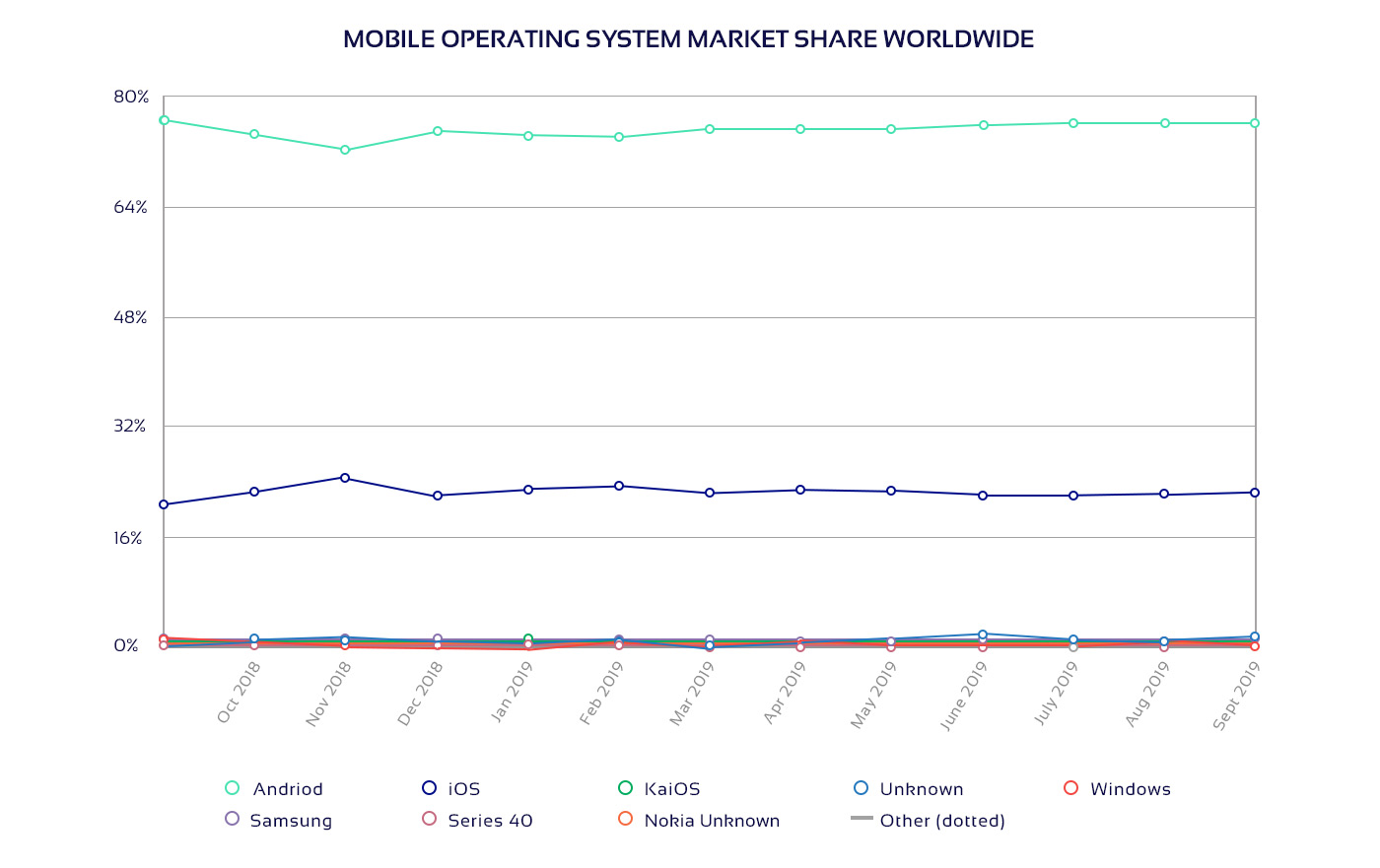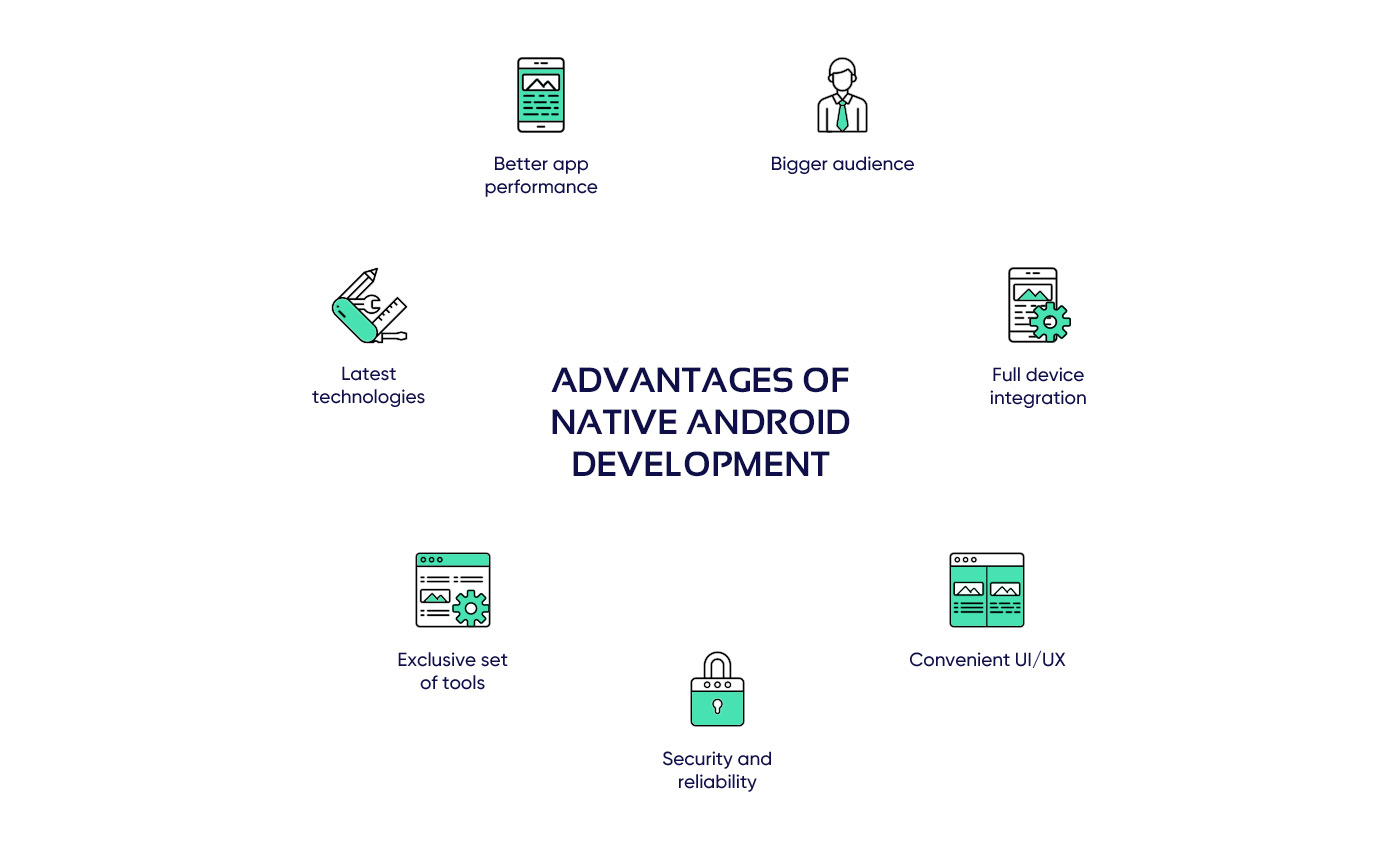The global market share of the Android operating system is almost 80%, which makes it a profitable target for many business owners. However, they have to choose between a native solution and a hybrid one for their app. The native development approach allows you to cover a big audience. At the same time, it puts the quality of app performance first to make users satisfied and, hence, increase your profits. This article will help you learn more about the peculiarities of native application development for Android OS. You will also find out what benefits it has over hybrid and cross-platform mobile programming
What Is Native Android Development?
Native app development for Android is the process of creating mobile applications exceptionally for the devices running on this operating system. When developing a native application, programmers use Java or Kotlin – the two official languages for Android development.
At the beginning of this article, we noted that around 80% of people on Earth use Android OS-based devices. Apple’s iOS goes next covering almost all 20% remained. These results make both operating systems the biggest rivals in the mobile app market. However, entrepreneurs often choose to target the Android OS to cover a larger audience.

One of the distinctive features that professional developers highlight in native apps is the feeling they give users. Figuratively speaking, these apps “reach their home” as soon as a person downloads them directly from the Google Play Store. Being “home”, these apps run as smoothly as any built-in OS feature and are able to access device capabilities (like storage, camera, microphone, etc.). The more device capabilities are available, the more functionalities users get, and the longer the duration of one user session in your app is. Now, let us compare how real Android apps differ from the applications built with other mobile programming approaches.
How Android Native App Development Is Peculiar?
Programmers create native Android applications only with native languages and official tools provided by Google. These apps are fast, highly performant, and fully compatible with devices running on this particular mobile platform. They feel like an integral part of the device OS, hence, they increase user satisfaction by giving smooth authentic user experience.
Alternatively to native programming, hybrid and cross-platform development approaches are getting popular because they allow programmers to create apps running on both Android and iOS. Still, they pose various restrictions for development and usually depend on native components in code. Hybrid apps can include some native elements to solve platform-specific issues, whereas cross-platform development relies on the native rendering process. This makes hybrid and cross-platform applications inferior to the native ones by responsiveness and performance.
What Are Native Android App Languages?
Java and Kotlin are the two official programming languages supported by Google’s Android Studio – an official integrated development environment for building native apps. In 1995, Sun Microsystems Inc. created a general-purpose Java language that follows the rule: “write once, run anywhere”. It means that Java can work on all platforms that support it to make the development process easier. With the rise of Android OS, it became the first and the most used native language for this mobile platform.
In 2011, the Jet Brains company designed the first version of Kotlin. This language relies on Java Virtual Machine and was primarily created to be more concise than Java code. In May 2019, at the Google I/O conference Kotlin was declared a preferred language for Android development.
Besides Java or Kotlin, programmers can also use the Android Native Development Kit to build an app in C or C++. Specialists write code with C or C++ when they need to fix critical performance issues related to the device processor. For example, to improve the processing speed when the device is running dynamic apps like video games.
7 Advantages of Native Android Apps Development
The three factors underline the advantages of native Android apps:
- the benefits that native development offers in general;
- the comparison with hybrid and cross-platform approaches;
- the number of devices covered in contrast to iOS development.

Based on these three factors, we uncovered seven valid reasons why business owners choose to create native applications for Android:
- High performance. Since programmers develop an app only for the Android platform, they don’t have to double some operations or design features as in hybrid or cross-platform development. The code is more structured and readable, which eases further testing, debugging, and deployment of the software product. As a result, you get a glitch-free native application able to process data efficiently and work with no delays.
- Variety of device model modifications. In case of iOS development, programmers create apps for Apple devices that follow almost the same UI design pattern. Numerous Android-based devices vary by model and screen size, so their user interfaces must be adapted. Native screen adaptation tools help developers optimize UI for completely different device types and models easily. As a result, a native app can run smoothly on various devices and cover a bigger audience.
- Full compatibility with Android devices. A native app can easily access device features (such as camera, storage, contacts, geolocation, etc.) that enrich the scope of application functionalities. For instance, with geolocation data, companies can set loyalty programs or promo offers for their customers. When customers pass by your offline store, for example, they will receive notifications about available discounts on the current location and may get interested in your services.
- Convenient UI/UX. No matter how advanced hybrid or cross-platform solutions can be, none of them impart the native “feel” of the real Android apps. As soon as they are on a user’s device, they become an integral part of the operating system and follow the logic of this device. Thus, people enjoy the Android native app design and get authentic user experience.
- Increased security and reliability. Native Android applications rely on numerous layers of protection provided by the operating system instead of browser security as in hybrid apps. The official development kit is enough to build fully-functional and secure apps, so programmers don’t have to integrate any third-party tools that can possibly damage the app architecture.
- Exclusive built-in tools. The Android SDK has an enormous amount of features that make the development process go faster. It includes a set of tutorials for developers, detailed APIs documentation, a debugger, an emulator, sample source code, and resourceful libraries. The SDK updates with the release of every new version of the OS, so programmers get new tools timely to use them right away.
- Usage of the latest technologies. A developer doesn’t have to find ways to solve platform-specific tasks and rely on some third-party tools when creating an Android app. With official Google support, the native set of development tools quickly updates and improves, so a specialist uses the latest features that ensure high quality of an app and speed up the development process.
Conclusion
Native development for Android OS offers various advantages to make business ideas profitable. It imposes fewer restrictions and dependencies for programmers than cross-platform or hybrid approaches, so the development process goes smoother. When downloaded to Android-based devices, authentic apps act as an integral part of the smartphone, watch, or tablet. They easily access device capabilities, offering more features to users and increasing their satisfaction. If you want to ensure such fast performance and multifunctionality for your Android application, contact us and get a high-quality native solution.




